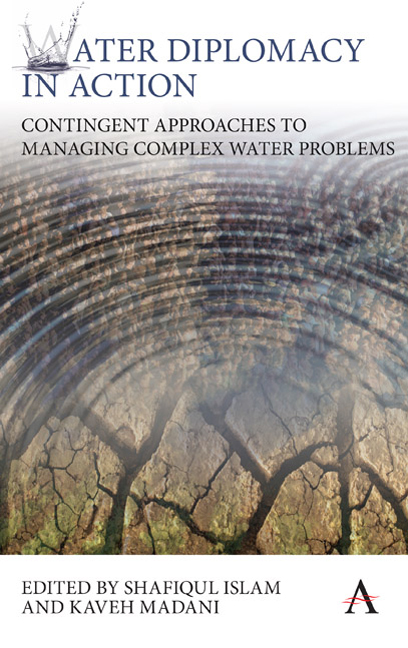Book contents
- Frontmatter
- Contents
- List of Figures
- List of Tables
- The Blind Men, the Elephant and the Well: A Parable for Complexity and Contingency
- Preface
- Part I ROOTS AND CAUSES OF COMPLEXITY AND CONTINGENCY IN WATER PROBLEMS
- Part II TOOLS, TECHNIQUES, MODELS AND ANALYSES TO RESOLVE COMPLEX WATER PROBLEMS
- Chapter Three Ten Bankruptcy Methods for Resolving Natural Resource Allocation Conflicts
- Chapter Four Flexible Design of Water Infrastructure Systems
- Chapter Five Extreme Value Analysis for Modeling Nonstationary Hydrologic Change
- Chapter Six The Water– Food Nexus and Virtual Water Trade
- Chapter Seven A Hybrid Analytical Approach for Modeling the Dynamics of Interactions for Complex Water Problems
- Chapter Eight A Call for Capacity Development for Improved Water Diplomacy
- Chapter Nine Water Complexity and Physics- Guided Data Mining
- Part III CASE STUDIES
- Notes on Contributors
- Index
Chapter Five - Extreme Value Analysis for Modeling Nonstationary Hydrologic Change
from Part II - TOOLS, TECHNIQUES, MODELS AND ANALYSES TO RESOLVE COMPLEX WATER PROBLEMS
Published online by Cambridge University Press: 10 January 2018
- Frontmatter
- Contents
- List of Figures
- List of Tables
- The Blind Men, the Elephant and the Well: A Parable for Complexity and Contingency
- Preface
- Part I ROOTS AND CAUSES OF COMPLEXITY AND CONTINGENCY IN WATER PROBLEMS
- Part II TOOLS, TECHNIQUES, MODELS AND ANALYSES TO RESOLVE COMPLEX WATER PROBLEMS
- Chapter Three Ten Bankruptcy Methods for Resolving Natural Resource Allocation Conflicts
- Chapter Four Flexible Design of Water Infrastructure Systems
- Chapter Five Extreme Value Analysis for Modeling Nonstationary Hydrologic Change
- Chapter Six The Water– Food Nexus and Virtual Water Trade
- Chapter Seven A Hybrid Analytical Approach for Modeling the Dynamics of Interactions for Complex Water Problems
- Chapter Eight A Call for Capacity Development for Improved Water Diplomacy
- Chapter Nine Water Complexity and Physics- Guided Data Mining
- Part III CASE STUDIES
- Notes on Contributors
- Index
Summary
Abstract
Robust communication of hydrologic risk is one of the most important factors for ensuring a sustainable water future by virtue of directly influencing infrastructure designs. Under transient conditions, the risk of hydrologic extremes needs to be properly assessed, taking into consideration the associated uncertainties. This chapter describes the methods for characterizing nonstationary behavior in hydrologic extremes within the framework of statistical extreme value theory (EVT), with particular emphasis on estimation of design flood quantiles and their uncertainties under transient conditions. Applications of such methods are demonstrated through a real- world case study for extreme rainfall at a location in India. Toward the end, we also include a discussion on the associated caveats and existing alternate scientific views on the notion of nonstationarity.
Introduction
Hydrologic extremes such as floods constitute complex water problems that affect societies through direct and indirect interactions with natural and man- made systems. While such extremes are rare by their very definition, they need to be all the more properly investigated for robust estimation of associated risks. Rapidly changing conditions such as those due to land use or land cover changes, human- interventions and climate change can aggravate the risk of such extremes (Sivapalan and Samuel 2009), thereby emphasizing the necessity of a comprehensive analysis and modeling for an uncertain water future. For example, a warmer world under a greenhouse effect can hold more moisture leading to an intensification of the hydrologic cycle that can possibly lead to more severe floods (Milly et al. 2008). On the other hand, land- use effects such as urban development may lead to increases in peak runoff, even without changes in the total or mean flows. This issue is all the more consequential for a developing region such as India, where economic growth and rapid development are undeniable realities. Traditionally, hydrologic designs are based on the assumption of stationarity, which can be questioned under transient conditions. It is common for hydrologists to estimate the 100- year flood based on the statistical theory of extreme values, extrapolating the model derived from observed values for possibly less than a hundred years.
- Type
- Chapter
- Information
- Water Diplomacy in ActionContingent Approaches to Managing Complex Water Problems, pp. 75 - 94Publisher: Anthem PressPrint publication year: 2017



